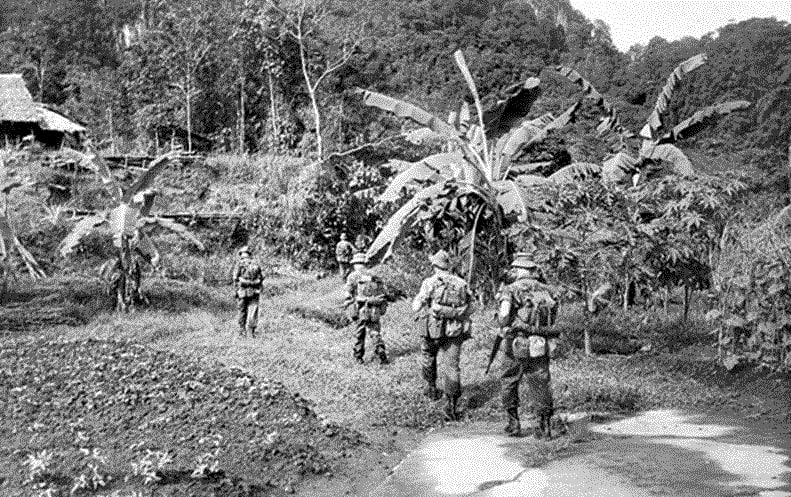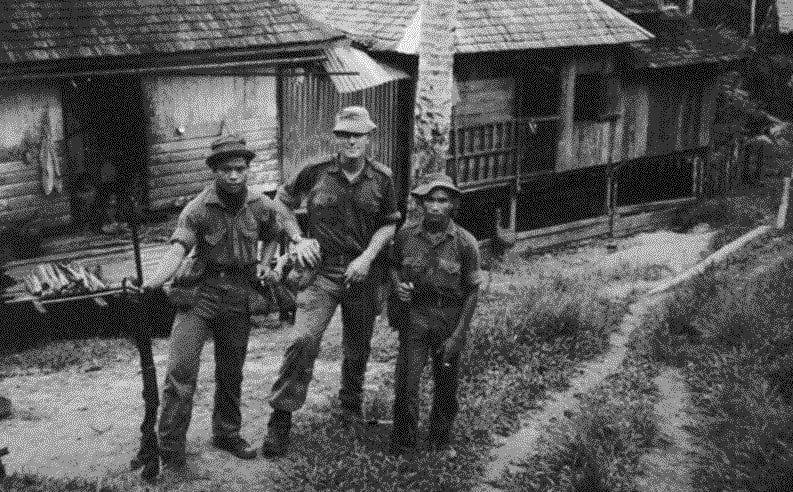by Andy Khong
Konfrontasi, also known as the Indonesia–Malaysia Confrontation, was a period of armed conflict that occurred from 1963 to 1966. It involved Indonesia’s opposition to the creation of Malaysia, which was formed by combining the Federation of Malaya, Singapore, North Borneo (now Sabah), and Borneo (now Sarawak). Brunei initially intended to join the formation of Malaysia, but later withdrew because the Sultanate (Royal Family) had concerns over its autonomy and preferred to remain a separate entity. Federation of Malaya consists of 9 states (Perlis, Kedah, Perak, Selangor, Negeri Sembilan, Johor, Pahang, Kelantan, Terrenganu), and 2 of the 3 Straits Settlements (British Territories) being Penang, and Malacca. Singapore being the 3rd Straits Settlements did not join the Federation of Malaya in 1957
In 1962, the Cobbold Commission established that two-thirds of the people of North Borneo (Sabah), and Borneo (Sarawak) accepted the Malaysia Concept, but Indonesia and the Philippines were not satisfied with the findings of the Commission.
The conflict escalated when Indonesia led by President Sukarno decided to “Ganyang Malaysia” (Crush Malaysia), opposed the inclusion of the North Borneo (Sabah), Borneo (Sarawak), and Singapore into Malaysia. Indonesia believed that the creation of Malaysia was a form of neo-imperialism, and neo-colonialism and saw it as a threat to its territorial integrity, and the aspirations of Indonesian-speaking populations in the neighbouring territories.

President Sukarno of Indonesia who decided to “Ganyang Malaysia” (Crush Malaysia).
During Konfrontasi, Indonesian forces, including regular troops and irregular armed groups, conducted military and guerrilla operations against the newly created country of Malaysia. The armed incursions, and acts of subversion and sabotage, including bombings, to destabilise Malaysia led to several military engagements and security challenges in the region.
To support Malaysia, the United Kingdom, Australia, and New Zealand provided military assistance in the form of troops and logistical support. Additionally, forces from Malaya, Brunei, and Singapore also played a role in countering the Indonesian aggression. United States, and Canada provided indirect support to Malaysia during the Confrontation. While they did not deploy combat forces, they offered diplomatic support, and economic aid to Malaysia, and other Commonwealth nations involved in the conflict. Indonesia on the other hand, received indirect support from China, and Soviet Union.


President Sukarno envisioned a unified entity of Maphilindo comprising Malaya, the Philippines, and Indonesia. The concept of Maphilindo was initially proposed as a cultural and economic cooperation initiative in that region. However, as the idea of Malaysia’s formation took shape, Sukarno’s stance shifted, and he opposed the inclusion of North Borneo (Sabah), Borneo (Sarawak), and Singapore in the creation of Malaysia.
In summary, Konfrontasi was a complex period of armed conflict driven by Indonesia’s opposition to the creation of Malaysia, leading to military engagements involving multiple countries. The situation involved geopolitical interests, regional aspirations, and historical complexities, making it an important chapter in the history of South-East Asia.
“Sabah Claim” by the Philippines:
The Philippines was not directly involved in Konfrontasi (Indonesia–Malaysia Confrontation) conflict.
However, the Philippines did have a territorial claim over the eastern part of North Borneo (Sabah). The claim was based on historical, cultural, and geographic factors, and known as the “Sabah Claim“.
The Sultanate of Sulu, a Muslim sultanate that existed for centuries in the southern Philippines, historically held claims over territories that included parts of northern Borneo, part of present-day Sabah. In the late 19th century, the Sultan of Sulu leased the territory of Sabah to a British trading company, which eventually led to British control over the area. After World War II, the Philippines continued to assert its claim over Sabah, considering it part of its territory.
The Resolution of Konfrontasi and Territorial Claims
Konfrontasi came to an end in 1966 when General Suharto replaced President Sukarno in Indonesia. The new Indonesian leadership sought to normalize relations with Malaysia and other countries in the region. A peace treaty was signed between Indonesia and Malaysia, officially ending the conflict.
Regarding the territorial claims, the “Sabah Claim” by the Philippines and the territorial claim by Indonesia over Sarawak and Sabah did not find resolution during Konfrontasi. These claims have remained sensitive issues in the region and have continued to be subjects of diplomatic discussions and negotiations between the involved parties.
In conclusion, Konfrontasi was a significant conflict with far-reaching implications for regional stability and territorial disputes. It showcased the complexities of historical and geopolitical factors in South-East Asia. While the conflict itself ended with a peace treaty, the territorial claims over Sarawak and Sabah persist, and the issue remains relevant in the region’s diplomatic landscape, and continues to shape relations among nations involved in the region.
Note: Due to social unrest, racial tensions, and political differences, Singapore was expelled from Malaysia, and became an independent republic on 9th August 1965.
Borneo Island is the 3rd largest island in the world after Greenland, and New Guinea. It is made up of Brunei, Sabah (North Borneo) and Sarawak (Borneo) [which are now part of Malaysia], and Kalimantan [which belongs to Indonesia]. You might be interested in reading:
Brunei: https://www.youngpioneertours.com/brunei-tranquil-abode/
Sabah: https://www.youngpioneertours.com/sabah-where-nature-culture-and-adventure-converge/
Sarawak: https://www.youngpioneertours.com/sarawak-where-nature-culture-and-adventure-unite/





